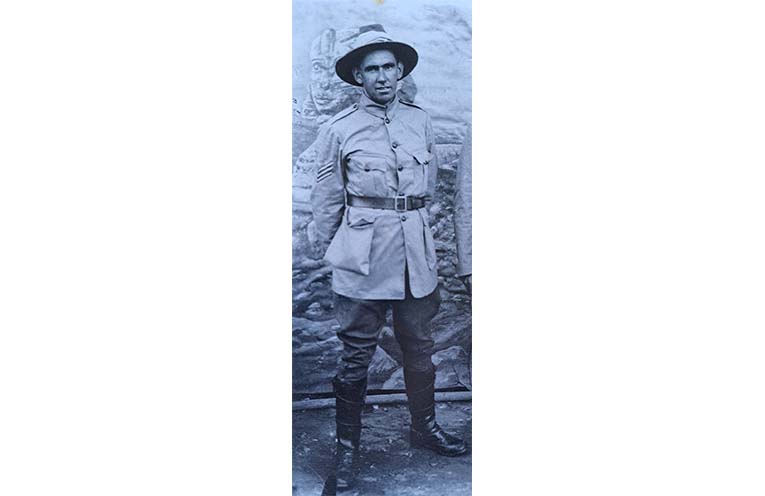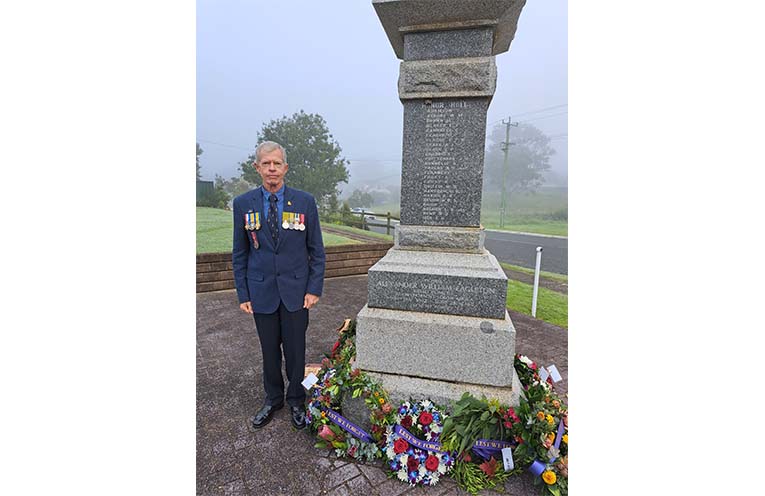THE most highly decorated soldier memorialised on the Clarence Town War Memorial is SGT Leslie (Les) Spurgeon Holmes, who was awarded the Distinguished Conduct Medal (DCM) in WWI.
The second youngest child of the 15 children of William Henry Holmes and his wife, Catherine Emily Dark, Les was born on the family property ‘Oakendale’ at Glen Oak in 1884 and worked on the farm.
Les travelled to Holsworthy, south of Sydney, aged 30 to enlist in the AIF in December 1914.
Given his ability to ride, Les was assigned as a trooper to the 2nd Reinforcement 7th Light Horse Regiment (7LHR) of the 2nd Light Horse Brigade.
He undertook his initial military training at Holsworthy and then embarked for Egypt where he joined the 7LHR.
The 7LHR was deployed to Gallipoli from 20 May 1915 until withdrawn on 20 December 1915.
After two months of fighting, Les was wounded at ANZAC Cove, but not seriously.
The following day he was promoted to Lance-Corporal and eventually to Corporal, remaining at Gallipoli until the 7LHR withdrawal.
7LHR embarked for Alexandria in December 1915, but by January 1916 Les was sick with a serious bowel infection and admitted to hospital, remaining hospitalised until March 1916.
During April-October 1916, 7LHR were part of the defence of the Suez Canal and engaged in small battles across Sinai to Romani, where Les was promoted to Sergeant (SGT).
In early 1917 the Allies were taking the fight to the Turkish forces with Gaza then Beersheba the intended objectives.
The First Battle of Gaza took place from 25-27 March 1917, and the 7LHR as part of the screen force advanced at the rear of Gaza in dense fog and to the complete surprise of the Turkish.
Les was leading a section when a Turkish patrol and gharries (horse drawn carriages) were spotted.
His section galloped down the Turkish and captured the gharries, with their troopers riding off in panic followed by most of the troop.
They had just captured the incoming Turkish Divisional Commander and staff, who was taking over the command of Gaza.
For this action and others, SGT LS Holmes was awarded the DCM on 17 May 1917.
Les was also part of the famous Battle of Beersheba (31 October-1 November 1917), although the 7LHR was not part of the historic Light Horse charge into the actual township of Beersheba.
The 7LHR as part of the Australian Mounted Division advanced through the Judean hills towards Jaffa and Jerusalem.
Les found his Squadron involved in many minor skirmishes and battles and at one point half a troop of ‘A’ Squadron was killed by a single explosive shell.
They continued to advance with the 7LHR capturing over 500 Turkish men on 9 November 1917, finishing with Jerusalem surrendering on 9 December 1917.
In March 1918, the 7LHR was encamped outside Jerusalem before continuing advancing towards Amman.
After a strenuous climb over a mountain pass the 7LHR found itself the advance guard of the Division and was approaching the ridges in front of Amman.
Heavy rain had fallen in the previous days and the ground was muddy.
An assault towards an enemy aerodrome was stopped by heavy machine gun and shell fire.
Many were wounded and all dropped to the ground in the mud.
A general withdrawal was undertaken and the 7LHR regrouped some 800m in the rear.
The attack was recommenced on the afternoon of 28 March but the 7LHR was much reduced and only 100 soldiers could be mustered for the attack.
The attack was again halted when many Turkish sangars with machine guns blocked the way.
With mounting casualties the 7LHR again withdrew.
Les’ luck had finally run out and he was shot through the face, with one bullet grazing his forehead and a second through his lower left jaw giving him a severe compound fracture.
His evacuation must have been tortuous but not unusual, taking 16 days of no-doubt enormous pain before reaching hospital in Port Said, Egypt.
After two weeks he was embarked on a hospital ship for return to Australia arriving in Sydney in August 1918.
He was to undergo surgical and medical care which continued for the rest of his life.
After being absent for almost four years Les returned home to the family property ‘Oakendale’.
On 15 November 1918, he was given a large official welcome home party at the nearby Glen Oak School of Arts as recorded in the Maitland Daily Mercury.
“One of the largest and most representative meetings ever held in Glenoak gathered… to welcome home Sgt Leslie Holmes, D.C.M,” the story stated.
He was officially discharged from the AIF on 28 March 1919.
In 1919, he married Miss Kathleen Sergeant of Glen Innes and remained farming on ‘Oakendale’.
Les was elected to Port Stephens Shire Council in 1921 and remained active in local affairs.
Les died in 1960, aged 76 years.
His WWI service is also memorialised at the Glen Oak School of Arts on the Memorial Gate and the wooden Honour Board mounted inside the building (along with two of his nephews).
For his military service Les was awarded the DCM, 1914/15 Star, Victory Medal, British War Medal and Australia Service Medal 1939-1945.
By Major Martin HOLMES CSM (retired)
You can help your local paper.
Make a small once-off, or (if you can) a regular donation.
We are an independent family owned business and our newspapers are free to collect and our news stories are free online.
Help support us into the future.





